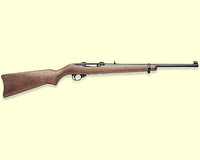
If you’ve been on a Plinkers outing, you’ve fired this gun. I bought it when I was 10 years old with lawn-mowing money, and it’s been a workhorse ever since. Many cans, jugs, paper targets and one skunk have fallen to this trusty tool. It occurred to me that the Ruger 10/22 deserves a review here.
The 10/22 is a semi-auto carbine in .22LR and the most popular rimfire rifle ever made, with several million sold since its introduction in 1964. What began as a wood-stocked, blued steel carbine is now offered in 13 different flavors, including one in .22 Magnum. While mine is close to the original configuration with a dark, hardwood stock, blued steel and a barrel band, 10/22s can also be had with target barrels, laminate or synthetic stocks and stainless steel hardware from the factory.
At only 5 ¼ pounds and 37 inches, one of the first things you notice about the 10/22 is that it is light and compact. It handles quickly and fits comfortably. The innovative flush-mounted rotary magazine contributes to the clean lines. It’s a good size for young shooters or smaller adults but not so downsized that it’s awkward for people who take up a little more space.
The 10/22 is a semi-auto. This is all I’d consider as a youth. Though I started shooting with a .22 bolt-action at age 5, when I was ready for my own gun I wanted firepower! The gun came with Ruger’s clever, detachable 10-round rotary magazine, and this was fun. After a couple more lawns, though, I had to get a 25-round “banana” magazine. Precision shooting was fun, but letting loose with 25 rounds in short order is a thrill that’s hard to beat. Though I’ve since retired my 25-rounder to comply with local laws, I’d still recommend unloading a high-capacity magazine as fast as you can if you ever have the opportunity.
As I got older and got a bit of the GI Joe out of me, I became more interested in accuracy. Although the 10/22 can be made a true “tack driver,” the base model that I own is pretty good. I’m not going to be punching holes in quarters at 100 yards, but it is quite satisfying with iron sights at close range and with a decent scope a bit further. With good ammo, it’s quite consistent. I’ve heard that standard velocity ammo is the most accurate, but I’ve found CCI Mini-Mags (high velocity) to be utterly reliable, reasonably priced and accurate enough for my purposes.
Regarding reliability, I can’t recall ever having a failure to feed or fire with my 10/22. I’m sure it’s happened. I used to use the really cheap bulk ammo that comes in the little green “milk carton,” and I’m sure that I had a failure to fire at one point or another with those. I’ve never had a problem with CCI, however, and the design of the 10/22, particularly with the 10-round factory mags can be counted on.
It is not possible to write about the 10/22 without addressing customization. Though not everyone does it, I’d venture to guess that a large part of the 10/22’s appeal now is the fact that you can literally replace every single part of it with some type of upgrade or alteration. It’s not uncommon for people to pay $200 for the base rifle and put several times that into it. Customizing the 10/22 is not required, but it is fun. For many years, I made do with a leather sling and a $10 scope. In the past few years I’ve made a few changes to it but nothing too radical. If you’d like to know what I’ve done, I’ll paraphrase the grandparent bumper stickers that were popular years ago—“Ask me about my gun.”
As a side note, I’ve read that the Israeli Defense Force has used silenced 10/22s for crowd control and discretely dealing with dogs and have heard rumors that South Koreans have been issued 10/22s along the DMZ (perhaps someone could confirm the latter).
So, do I have any complaints about the 10/22? As it comes from the factory, the trigger’s a little stiff, the magazine and bolt releases are awkward and the little dovetail scope mount is wimpy. All of these you can live with or easily and cheaply improve with aftermarket parts.
[I’d be curious to hear the impressions of others, as well. Let me know if you like to offer a review of this gun or any other.]

